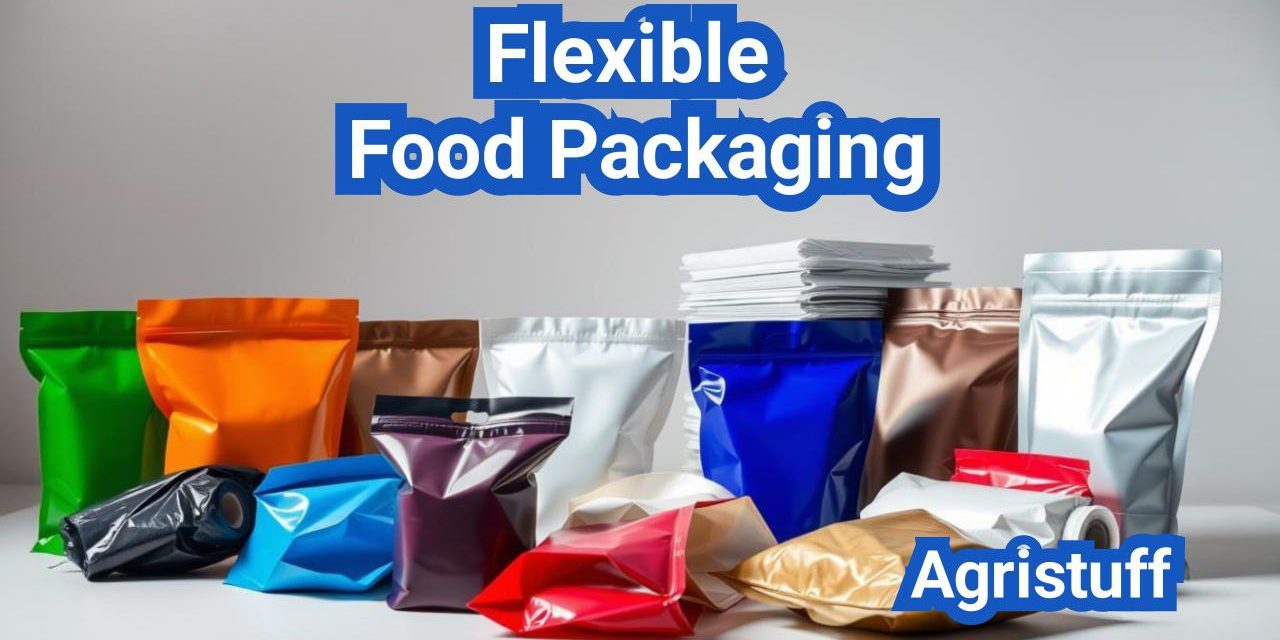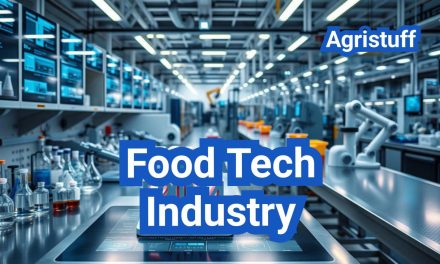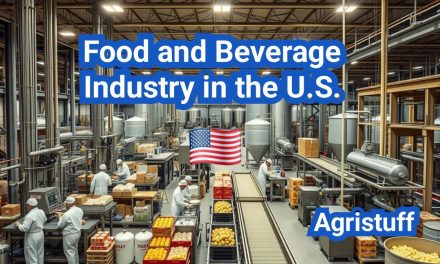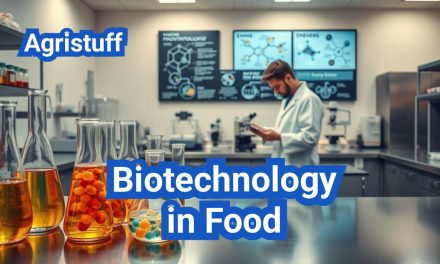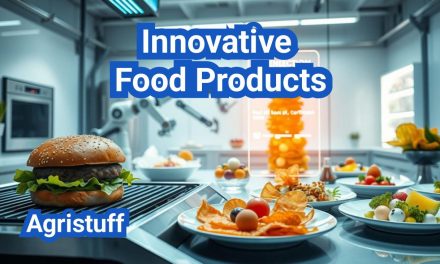The food packaging industry has witnessed a significant shift towards flexible packaging solutions, driven by their versatility, convenience, and sustainability benefits. Among these, pouches and films have emerged as particularly popular formats.
Flexible packaging materials offer a range of benefits, including reduced material usage and lower carbon footprints. The importance of barrier properties in maintaining the quality and freshness of packaged products cannot be overstated.
As the demand for convenient and sustainable packaging continues to grow, understanding the role of pouches, films, and barrier properties in flexible packaging is crucial for manufacturers and consumers alike.
Key Takeaways
- The packaging industry is shifting towards flexible packaging solutions.
- Pouches and films are popular formats in flexible packaging.
- Barrier properties play a crucial role in maintaining product quality.
- Flexible packaging offers several benefits, including reduced material usage.
- Understanding flexible packaging is essential for manufacturers and consumers.
The Fundamentals of Flexible Food Packaging
The shift from rigid to flexible packaging is transforming the food packaging landscape. This revolution is driven by the numerous benefits offered by flexible packaging, including reduced material usage, lower shipping costs, and improved product protection.
From Rigid to Flexible: A Packaging Revolution
The food packaging industry has witnessed a significant shift from rigid to flexible packaging in recent years. Flexible packaging offers numerous advantages, including convenience, sustainability, and cost-effectiveness. The use of flexible materials such as pouches, films, and laminates has become increasingly popular due to their ability to provide excellent barrier properties and product protection.
Current Market Size and Growth Trends
The global flexible food packaging market is experiencing rapid growth. According to recent data, the global BOPP film market was $24.2 billion in 2020 and is projected to grow to $31.4 billion by 2025. This growth is driven by increasing demand for convenient and sustainable packaging solutions.
| Market Segment | 2020 | 2025 (Projected) |
|---|---|---|
| BOPP Film Market | $24.2 billion | $31.4 billion |
| Flexible Packaging Market | $140 billion | $215 billion |
Leading Flexible Food Packaging Companies
Several companies are leading the way in flexible food packaging. Some of the key players include:
- Amcor Limited
- Sealed Air Corporation
- Flexopack SA
- Coveris Holdings SA
- Bemis Company Inc.
These companies are driving innovation and providing a range of flexible packaging solutions to the food industry.
Essential Materials Used in Flexible Food Packaging

Flexible packaging for food products utilizes various materials, each selected for its specific properties. The choice of material is critical in ensuring the packaged food remains fresh, safe, and appealing to consumers.
Common Base Materials
The most commonly used base materials in flexible food packaging include polyethylene (PE), polyethylene terephthalate (PET), aluminum foil, polypropylene (PP), and ethylene vinyl alcohol (EVOH). Each of these materials offers unique benefits, such as barrier properties, strength, and flexibility.
| Material | Key Properties | Common Applications |
|---|---|---|
| Polyethylene (PE) | Flexible, moisture barrier | Packaging films, pouches |
| Polyethylene Terephthalate (PET) | Strong, clear, oxygen barrier | Food packaging, labels |
| Aluminum Foil | Excellent barrier, durable | Coffee packaging, snack packaging |
| Polypropylene (PP) | Resistant to heat, chemicals | Retort pouches, microwave-safe packaging |
| Ethylene Vinyl Alcohol (EVOH) | High oxygen barrier | Multi-layer packaging structures |
Specialty Films and Laminates
Specialty films and laminates are designed to provide specific functionalities, such as enhanced barrier properties or improved sealability. These materials are often used in multi-layer structures to achieve the desired performance characteristics.
Material Selection Criteria
The selection of materials for flexible food packaging involves considering several factors, including the type of food being packaged, the desired shelf life, and the packaging machinery used. Manufacturers must balance these factors with cost considerations and environmental sustainability.
By understanding the properties and applications of different materials, manufacturers can design effective packaging solutions that meet consumer needs and regulatory requirements.
Barrier Properties: The Key to Food Protection
Effective barrier properties are crucial for maintaining the quality and safety of packaged food products. Barrier properties determine how well packaging controls the internal atmosphere and protects the product from external factors such as moisture, oxygen, and light.
Understanding Oxygen Transmission Rate (OTR)
Oxygen Transmission Rate (OTR) is a critical measure of a packaging material’s ability to prevent oxygen from entering the package. High OTR values can lead to the degradation of food quality, causing issues such as rancidity and loss of flavor. Low OTR values are essential for packaging oxygen-sensitive products.
Water Vapor Transmission Rate (WVTR) Explained
Water Vapor Transmission Rate (WVTR) measures the rate at which water vapor passes through a packaging material. High WVTR can result in moisture accumulation inside the package, potentially leading to mold growth or texture changes in the food product. WVTR is particularly important for dry foods and snacks.
Light, Aroma, and Grease Barriers
In addition to OTR and WVTR, other barrier properties play significant roles in food packaging. Light barriers protect products from photodegradation, aroma barriers prevent the loss of flavor and aroma, and grease barriers stop the migration of oils and fats through the packaging material.
- Light barriers are crucial for products sensitive to light exposure.
- Aroma barriers help maintain the product’s flavor profile.
- Grease barriers prevent staining and leakage.
How to Measure and Test Barrier Performance
Measuring and testing barrier performance is vital to ensure that packaging meets the required standards. Techniques include:
- OTR testing using standardized methods like ASTM D3985.
- WVTR testing following standards such as ASTM F1249.
- Light transmission testing to assess the material’s light barrier properties.
By understanding and optimizing barrier properties, manufacturers can significantly enhance the shelf life and quality of their food products.
Advanced Barrier Technologies for Extended Shelf Life

Advanced barrier technologies play a crucial role in maintaining the quality and freshness of packaged food. These technologies are designed to protect the contents from external factors such as oxygen, moisture, and light, which can compromise the product’s integrity.
Implementing EVOH Barrier Layers
Ethylene-vinyl alcohol (EVOH) copolymers are widely used for their excellent oxygen barrier properties. EVOH barrier layers are particularly effective in preventing oxygen ingress, thereby extending the shelf life of oxygen-sensitive products.
“The use of EVOH in barrier applications has become a standard in the packaging industry due to its high barrier performance,” according to industry experts.
Working with Metallized PET and Other Metallized Films
Metallized PET (Polyethylene Terephthalate) and other metallized films offer a robust barrier against light, moisture, and oxygen. The metallization process involves depositing a thin layer of metal, typically aluminum, onto the film surface. This enhances the barrier properties of the film, making it suitable for packaging a wide range of food products.
- Provides excellent barrier against light and moisture
- Enhances shelf life by preventing oxygen ingress
- Can be used in various packaging formats, including pouches and wraps
Nanocomposite Barriers: Applications and Benefits
Nanocomposite barriers represent a cutting-edge technology in the field of flexible packaging. By incorporating nanoparticles into the packaging material, manufacturers can achieve enhanced barrier properties. Nanocomposites offer improved resistance to oxygen, moisture, and other external factors, making them ideal for packaging perishable goods.
Selecting the Right Barrier Coatings
The selection of barrier coatings depends on several factors, including the type of product being packaged, the desired shelf life, and the packaging format. Barrier coatings can be applied to various substrates to enhance their barrier properties. Common types of barrier coatings include silicon oxide (SiOx) and aluminum oxide (AlOx) coatings.
As stated by a leading packaging expert, “The right barrier coating can significantly enhance the performance of flexible packaging, ensuring that the product remains fresh and protected throughout its shelf life.”
How to Choose the Right Pouch Format for Your Product
The choice of pouch format can significantly impact product shelf life and consumer convenience. With various options available, manufacturers must carefully consider their product’s specific needs when selecting a pouch format.
Stand-Up Pouches: Design and Applications
Stand-up pouches (SUPs) have gained popularity due to their convenience, display benefits, and ability to stand upright on store shelves. These pouches are ideal for products like snacks, pet food, and beverages. The design of stand-up pouches typically includes a bottom gusset that allows them to stand upright, making them more visible and accessible to consumers.
Key benefits of stand-up pouches include:
- Enhanced shelf presence
- Improved consumer convenience
- Flexibility in design and material selection
Retort Pouch Packaging for Heat-Processed Foods
Retort pouches are designed for heat-processed foods, offering a convenient and safe packaging solution. These pouches are made from multi-layer materials that can withstand high temperatures during the retorting process. Retort pouches are commonly used for ready-to-eat meals, soups, and sauces.
Advantages of retort pouch packaging:
- Ability to withstand high temperatures
- Convenient and portable
- Extended shelf life
Aseptic Pouches for Shelf-Stable Products
Aseptic pouches are used for shelf-stable products, providing a sterile environment that prevents the growth of microorganisms. These pouches are ideal for products like juice, pureed foods, and dairy products. Aseptic packaging involves filling and sealing the pouches in a sterile environment.
Key features of aseptic pouches include:
- Sterile packaging environment
- Extended shelf life without refrigeration
- Convenient packaging format
Implementing Specialized Closure Options: Zippers and Spouts
Specialized closure options like zippers and spouts can enhance the functionality and convenience of pouches. Zippers provide resealability, while spouts offer easy dispensing. These closure options are particularly useful for products like snacks, beverages, and liquid foods.
| Closure Option | Benefits | Typical Applications |
|---|---|---|
| Zippers | Resealability, convenience | Snacks, dry goods |
| Spouts | Easy dispensing, controlled pouring | Beverages, liquid foods |
By considering the specific needs of their product and the benefits of different pouch formats and closure options, manufacturers can make informed decisions about their packaging.
Designing Film Structures for Specific Food Applications

Flexible food packaging requires tailored film structures to meet the unique demands of various food products. Different foods have distinct requirements for barrier properties, such as protection from oxygen, moisture, or light, which can significantly impact their shelf life and quality.
Coffee Packaging: Achieving Optimal Barrier Properties
Coffee packaging is a prime example where film structure plays a critical role. Coffee beans and ground coffee are sensitive to oxygen, moisture, and light, which can cause them to lose flavor and aroma. To combat this, coffee packaging often employs multi-layer films that include barrier layers such as aluminum foil or ethylene-vinyl alcohol (EVOH) to block oxygen and moisture. The use of metallized PET can also enhance barrier properties while allowing for a more sustainable packaging solution.
Snack Packaging: Balancing Freshness and Presentation
Snack foods, including chips and crackers, require packaging that maintains freshness while also providing an attractive presentation. The film structure for snack packaging often includes a combination of materials that offer barrier properties against moisture and oxygen, as well as puncture resistance to protect against damage during handling. Additionally, the use of clear or transparent films can enhance product visibility, making the product more appealing to consumers.
Lidding Films for Dairy Products: Technical Requirements
Lidding films used for dairy products, such as yogurt and cheese, must adhere to strict technical requirements. These films need to provide a strong seal to prevent leakage and contamination, while also being easy to open. The film structure typically includes a layer that is compatible with the dairy product and a peelable sealant layer. Barrier properties are also crucial to prevent the ingress of oxygen and moisture, which can spoil the product.
Frozen Food Flexible Packaging Solutions
Frozen foods require packaging that can withstand low temperatures and maintain its integrity. The film structure for frozen food packaging often includes materials that are resistant to cold temperatures and provide a barrier against moisture and freezer burn. The use of multi-layer films can offer the necessary protection, while also being designed for efficient packaging processes such as vertical form-fill-seal (VFFS) or horizontal form-fill-seal (HFFS).
Implementing Modified Atmosphere Packaging (MAP)

Modified Atmosphere Packaging (MAP) is a sophisticated packaging technique that replaces the air in packaging with a gas mixture to preserve food. This method has gained significant attention in the food industry due to its effectiveness in extending shelf life and maintaining product freshness.
Extending Shelf Life with MAP
The primary goal of MAP is to extend the shelf life of food products by inhibiting the growth of microorganisms and reducing oxidation reactions. By adjusting the gas composition surrounding the product, manufacturers can significantly slow down the deterioration process. For instance, reducing oxygen levels can prevent the growth of aerobic bacteria and mold, while increasing carbon dioxide levels can further inhibit microbial growth.
Key benefits of MAP include:
- Extended shelf life without preservatives
- Maintained product freshness and quality
- Reduced food waste
- Enhanced product appearance
Selecting Gas Combinations for Different Food Types
The selection of gas combinations is critical in MAP and varies depending on the type of food product. Common gases used include oxygen (O2), nitrogen (N2), and carbon dioxide (CO2). For example, high CO2 levels are often used for fresh meat and poultry to inhibit bacterial growth, while N2 is used as a filler gas to prevent package collapse.
| Food Product | Recommended Gas Combination |
|---|---|
| Fresh Meat | High CO2, Low O2 |
| Bakery Products | High CO2, N2 |
| Fresh Fruits and Vegetables | Low O2, High N2 |
Equipment Selection and Implementation Process
The successful implementation of MAP requires the right equipment. This includes gas flushing machines, vacuum packaging machines, and modified atmosphere packaging machines. The choice of equipment depends on the product type, packaging format, and production volume.
Key considerations for equipment selection include:
- Compatibility with the chosen gas mixture
- Packaging speed and efficiency
- Integration with existing production lines
- Cost-effectiveness and return on investment
Essential Testing Methods for Quality Assurance

The quality assurance of flexible packaging involves a series of critical testing procedures to ensure its safety, efficacy, and overall performance.
Flexible packaging is subjected to various stresses during its lifecycle, from production to consumer use. Therefore, it’s crucial to implement comprehensive testing methods to validate its integrity.
Conducting Seal Strength Testing (ASTM F88)
Seal strength testing is a critical evaluation method for flexible packaging. It assesses the strength of the seal, which is vital for maintaining the package’s integrity. The test is conducted according to ASTM F88 standards.
The process involves:
- Preparing test samples with precise seal dimensions.
- Using a tensile testing machine to measure the force required to open the seal.
- Analyzing the results to ensure they meet the required standards.
Performing Dye Penetration Testing (ASTM F1929)
Dye penetration testing is used to detect leaks in the packaging. This method involves:
- Applying a dye to the package seal area.
- Allowing the dye to penetrate any potential leaks.
- Inspecting the package for signs of dye penetration, indicating a leak.
This test is particularly useful for identifying minute leaks that could compromise the packaging.
Implementing Burst Testing (ASTM F2054)
Burst testing evaluates the package’s ability to withstand internal pressure. The test is performed according to ASTM F2054 standards and involves:
- Inflating the package with air or water until it bursts.
- Measuring the pressure at which the package fails.
This test provides valuable insights into the package’s durability and resistance to bursting.
Comprehensive Barrier Property Testing Protocols
Barrier property testing is essential for ensuring that the packaging material provides adequate protection against external factors such as moisture, oxygen, and light. The testing protocols involve:
- Measuring the Oxygen Transmission Rate (OTR) using standards like ASTM D3985.
- Evaluating the Water Vapor Transmission Rate (WVTR) according to ASTM F1249.
These tests help in selecting the appropriate packaging material that meets the product’s specific barrier requirements.
Navigating Regulatory Compliance for Food Contact Materials

Navigating the complex landscape of regulations for food packaging is a critical task for manufacturers. Ensuring compliance with these regulations is not only a legal necessity but also crucial for consumer safety and trust.
Meeting FDA Food Contact Substances Requirements
The FDA regulates food contact substances to ensure they are safe for use. Manufacturers must comply with FDA regulations regarding the materials used in packaging. This includes ensuring that all substances used do not adulterate the food or pose a health risk.
FDA clearance is required for new food contact substances. This involves a thorough review process to assess the safety of the substance. Manufacturers should work closely with suppliers to ensure all materials meet FDA standards.
Complying with Thermal Processing Standards (21 CFR 113 and 114)
Thermal processing involves heating food to kill harmful bacteria. Regulations under 21 CFR 113 and 114 govern this process to ensure food safety. Compliance involves adhering to strict guidelines on processing temperatures, times, and packaging.
Manufacturers must validate their thermal processing procedures to ensure they meet regulatory requirements. This includes regular testing and documentation.
Understanding Labeling Requirements (21 CFR 101.105)
Labeling requirements are crucial for informing consumers about the product. Regulations under 21 CFR 101.105 specify what information must be included on labels, such as ingredient lists and nutritional information.
Accurate labeling is not only a regulatory requirement but also essential for consumer trust. Manufacturers should ensure their labeling complies with FDA regulations and is clear and understandable.
Addressing International Regulations
For companies exporting food products, understanding international regulations is vital. Different countries have varying standards for food contact materials and labeling.
Manufacturers must research and comply with the regulations of the countries they export to. This may involve adapting packaging materials and labeling to meet local requirements.
By understanding and complying with these regulations, manufacturers can ensure their products are safe, legally compliant, and market-ready. Staying informed about regulatory changes is crucial for ongoing compliance.
Manufacturing Processes for Flexible Food Packaging

The production of flexible food packaging utilizes several key manufacturing processes. These processes are crucial for creating packaging that is both functional and efficient.
Optimizing VFFS (Vertical Form-Fill-Seal) Systems
VFFS systems are widely used in the packaging industry for their efficiency and versatility. Optimizing VFFS systems involves adjusting parameters such as sealing temperature, pressure, and dwell time to ensure proper seal formation and prevent leaks.
To optimize VFFS systems, manufacturers should consider factors like film material, product characteristics, and production speed. Regular maintenance and monitoring of the equipment are also essential to prevent downtime and ensure consistent packaging quality.
Working with HFFS (Horizontal Form-Fill-Seal) Rollstock
HFFS systems are another critical manufacturing process for flexible food packaging. These systems are particularly useful for packaging products that are difficult to handle vertically, such as irregularly shaped items or products with high viscosity.
Effective use of HFFS rollstock requires careful consideration of factors like film tension, sealing parameters, and product placement. Manufacturers must also ensure that the HFFS system is properly integrated with other production equipment to maintain a smooth workflow.
Pouch Making and Converting Techniques
Pouch making and converting are essential steps in the production of flexible food packaging. Pouch making involves creating the pouch structure from film materials, while converting involves transforming the pouches into finished packaging products.
Advanced converting techniques, such as printing, laminating, and cutting, are used to add value to the packaging. Manufacturers must optimize these processes to achieve high-quality packaging that meets consumer expectations and regulatory requirements.
Sustainable Solutions in Flexible Food Packaging

Flexible food packaging is embracing sustainability, with innovative solutions that balance environmental concerns with packaging performance. As consumers increasingly demand eco-friendly products, manufacturers are responding with creative, sustainable packaging options.
Developing Recyclable Flexible Packaging
One of the key strategies in sustainable flexible packaging is the development of recyclable materials. This involves designing packaging that can be easily collected, sorted, and processed through existing recycling streams. Recyclable flexible packaging not only reduces waste but also conserves resources by allowing materials to be reused.
The use of mono-material PE films is gaining popularity as it simplifies the recycling process. Unlike multi-material laminates, mono-material structures can be more easily recycled, making them an attractive option for brands looking to improve their sustainability profile.
Implementing Mono-Material PE Films
Mono-material PE films offer several advantages, including improved recyclability and reduced environmental impact. By using a single material, manufacturers can simplify the production process and reduce costs associated with complex laminate structures.
These films are particularly suitable for applications where barrier properties are not the primary concern. For instance, snack packaging and other non-perishable food items can benefit from mono-material PE films without compromising on packaging performance.
Participating in Store Drop-Off Recycling Programs
Store drop-off recycling programs provide consumers with a convenient way to recycle their flexible packaging. By participating in these programs, brands can encourage consumers to return used packaging to designated collection points.
These programs are crucial for increasing the recycling rate of flexible packaging materials. As more consumers participate, the amount of material available for recycling increases, helping to create a more circular economy.
Using the APR Design Guide and How2Recycle Label
The Association of Plastic Recyclers (APR) Design Guide is a valuable resource for manufacturers looking to create more recyclable packaging. By following the APR’s guidelines, brands can ensure that their packaging is designed with recyclability in mind, improving its chances of being accepted by recycling facilities.
The How2Recycle label provides clear instructions to consumers on how to recycle packaging properly. By including this label on their products, brands can educate consumers and encourage participation in recycling programs, further enhancing the sustainability of their packaging.
As the flexible food packaging industry continues to evolve, the adoption of sustainable practices and materials will play a critical role in reducing environmental impact. By embracing recyclable materials, mono-material PE films, and participating in recycling programs, manufacturers can make significant strides towards a more sustainable future.
How to Select the Right Flexible Packaging for Your Food Product
Selecting the right flexible packaging for your food product is a critical decision that affects both product quality and consumer satisfaction. The process involves a comprehensive evaluation of several key factors.
Assessing Product Requirements and Shelf Life Goals
To choose the appropriate flexible packaging, you must first assess your product’s specific requirements and shelf life goals. Consider the type of food, its sensitivity to oxygen, moisture, and light, and the desired shelf life. For instance, products with high fat content may require packaging with enhanced grease resistance.
- Identify the product’s sensitivity to oxygen, moisture, and light.
- Determine the required shelf life and storage conditions.
- Consider the product’s texture and fragility.
Balancing Cost, Performance, and Sustainability
Achieving a balance between cost, performance, and sustainability is crucial in flexible packaging selection. While cost is an important factor, it should not compromise the packaging’s performance or sustainability.
Some key considerations include:
- Material selection: Choose materials that offer the required barrier properties while being cost-effective.
- Packaging design: Optimize the packaging design to minimize material usage without compromising protection.
- Sustainability: Consider eco-friendly materials and designs that reduce environmental impact.
Working Effectively with Packaging Suppliers
Collaboration with packaging suppliers is vital in selecting the right flexible packaging. Suppliers can provide valuable insights into material options, design possibilities, and regulatory compliance.
To work effectively with suppliers:
- Clearly communicate your product requirements and expectations.
- Request samples and prototypes for testing.
- Discuss cost-saving opportunities without compromising quality.
Conducting Testing and Validation Trials
Once you have selected a potential flexible packaging solution, it’s essential to conduct thorough testing and validation trials. This step ensures that the packaging meets your product’s specific needs and performs as expected.
Some testing methods include:
- Seal strength testing (ASTM F88).
- Dye penetration testing (ASTM F1929).
- Burst testing (ASTM F2054).
- Barrier property testing.
By following these steps and working closely with your packaging supplier, you can ensure that your flexible packaging meets your product’s requirements, enhances its shelf life, and aligns with your sustainability goals.
The Future of Flexible Food Packaging
The flexible food packaging industry is poised for continued growth, driven by consumer demand for convenience, sustainability, and innovative packaging solutions. As discussed, the use of advanced materials, barrier technologies, and modified atmosphere packaging (MAP) are crucial in extending shelf life and maintaining product freshness.
Emerging trends and innovations in flexible food packaging include the development of recyclable and biodegradable materials, as well as the integration of smart packaging technologies. Companies like Amcor, Sealed Air, and Mondi are at the forefront of these innovations, pushing the boundaries of what is possible in flexible packaging.
As the industry continues to evolve, it is essential to stay informed about the latest trends, technologies, and regulatory requirements. By understanding the future of flexible food packaging, businesses can make informed decisions and stay ahead of the competition. The future of flexible food packaging is exciting, with many opportunities for growth, innovation, and sustainability.
FAQ
What is flexible food packaging, and why is it becoming increasingly popular?
Flexible food packaging refers to packaging solutions that are flexible, such as pouches, films, and bags, used for containing and preserving food products. It’s becoming increasingly popular due to its convenience, cost-effectiveness, and ability to preserve food freshness.
What are the benefits of using flexible packaging for food products?
Flexible packaging offers several benefits, including reduced material usage, lower transportation costs, increased shelf life, and improved product protection. It also provides a wide range of design options and can be tailored to specific product requirements.
What materials are commonly used in flexible food packaging?
Common materials used in flexible food packaging include polyethylene (PE), polypropylene (PP), polyethylene terephthalate (PET), and various laminates and coatings. The choice of material depends on the specific product requirements, such as barrier properties, sealability, and durability.
What are barrier properties, and why are they important in food packaging?
Barrier properties refer to the ability of a packaging material to prevent the passage of gases, moisture, or other substances that can affect the quality and safety of the packaged food. Barrier properties are crucial in maintaining the freshness, texture, and flavor of food products.
How do I choose the right pouch format for my product?
Choosing the right pouch format depends on several factors, including product type, packaging requirements, and consumer preferences. Stand-up pouches, retort pouches, and aseptic pouches are popular options, each with its own advantages and applications.
What is modified atmosphere packaging (MAP), and how does it work?
Modified atmosphere packaging (MAP) involves replacing the air in the packaging with a gas mixture that inhibits the growth of microorganisms and preserves the product’s freshness. The gas combination is tailored to the specific product requirements, and the packaging material is designed to maintain the desired atmosphere.
What testing methods are essential for ensuring the quality of flexible food packaging?
Essential testing methods include seal strength testing (ASTM F88), dye penetration testing (ASTM F1929), burst testing (ASTM F2054), and barrier property testing. These tests help ensure that the packaging meets the required standards and is suitable for its intended use.
How do I ensure regulatory compliance for food contact materials?
To ensure regulatory compliance, it’s essential to familiarize yourself with relevant regulations, such as FDA food contact substances requirements, thermal processing standards, and labeling requirements. You should also consult with regulatory experts and suppliers to ensure that your packaging materials meet the necessary standards.
What are the latest trends in sustainable flexible food packaging?
The latest trends in sustainable flexible food packaging include the development of recyclable packaging, mono-material PE films, and participation in store drop-off recycling programs. The use of guidelines like APR Design Guide and How2Recycle label is also becoming increasingly popular.
How do I select the right flexible packaging for my food product?
To select the right flexible packaging, you should assess your product requirements, balance cost, performance, and sustainability, work effectively with packaging suppliers, and conduct testing and validation trials. This will help ensure that your packaging meets your product’s specific needs and is compliant with relevant regulations.
Conclusion of: Flexible Food Packaging
Introduction: why flexible food packaging matters now
Flexible food packaging has surged across U.S. grocery aisles because it protects food, lowers shipping weight, and enables eye-catching formats that consumers love, and this buyer’s guide explains what to consider so you can specify flexible food packaging with confidence. Flexible Packaging Association – industry overview
What is flexible food packaging?
At its core, flexible food packaging is any package made of materials that can easily change shape—such as films, foils, papers, or laminates—formed into bags, lidding, or pouches that protect products without the bulk of rigid containers, making flexible food packaging a versatile platform for many categories. FPA – advantages of flexible packaging
Why brands choose flexible food packaging
Compared with rigid options, flexible food packaging typically delivers a better product-to-package ratio, reduces transport emissions, and offers convenient features like zippers and spouts; this helps brands balance shelf life, cost, and sustainability when adopting flexible food packaging. FPA – sustainable packaging
Main formats within flexible food packaging
Common formats in flexible food packaging include fin-seal pillow bags, stand-up pouches (Doyen/K-seal), quad-seal bags, spouted pouches, lidding films for trays, and overwraps—each chosen for how the product is filled, sealed, shipped, and merchandised within flexible food packaging. FPA – format overview (download)
Where flexible food packaging is used on shelf
Snacks, coffee, baby food, dry mixes, frozen produce, jerky, cheese, and ready-to-eat meals all leverage flexible food packaging because it can be tuned for barrier, print quality, and opening/reclose features, expanding the role of flexible food packaging across departments. FPA – state of the industry
Materials 101 for flexible food packaging
Typical building blocks of flexible food packaging are polyethylene (PE), polypropylene (PP), polyester (PET), nylon (PA), barrier layers like EVOH, and sometimes aluminum foil; every layer that contacts food in flexible food packaging must be authorized for its use. FDA – Packaging & Food-Contact Substances
Barrier basics: OTR & WVTR in flexible food packaging
Two numbers guide barrier selection in flexible food packaging: oxygen transmission rate (OTR) for oxidation control and water vapor transmission rate (WVTR) for moisture control; standardized tests let you compare films fairly when engineering flexible food packaging. ASTM F1249 – WVTR test method
How multilayer films work in flexible food packaging
To hit target shelf life, flexible food packaging often uses coextruded or laminated stacks—for example, PET/ink/adhesive/EVOH/PE—that combine stiffness, clarity, printability, and heat-sealability; the structure is the heart of flexible food packaging performance. ASTM – packaging standards overview
Category-specific barrier choices in flexible food packaging
Snacks and nuts typically need low WVTR to fight staling, coffee and dried fruit need low OTR to preserve aroma and color, while fresh-cut produce uses breathable films to manage respiration, illustrating how product chemistry dictates flexible food packaging. UC Davis – postharvest training (MAP)
Sealing technologies behind flexible food packaging
Heat-seal remains the workhorse for flexible food packaging, but cold-seal adhesives help with heat-sensitive items and ultrasonic sealing can cut energy and improve seal integrity; defining seal windows (temperature, pressure, dwell) is vital in flexible food packaging. ASTM F2029 – seal parameter guidelines
Integrity testing for flexible food packaging
Before scale-up, verify seal strength (ASTM F88/F88M), check for channel leaks with dye penetration (ASTM F1929), and confirm burst resistance (ASTM F2054) so flexible food packaging performs throughout distribution. ASTM F88 – seal strength
Retortable options in flexible food packaging
Retort pouches used for shelf-stable meals must survive high-temperature sterilization and maintain seams, barrier, and print, so flexible food packaging for low-acid canned foods must follow strict U.S. regulations and records. 21 CFR Part 113 – LACF
Aseptic & acidified foods in flexible food packaging
Aseptic spouted pouches and acidified products rely on different validation paths and controls, but both demand proven materials and documentation so the flexible food packaging is safe and compliant at market. 21 CFR Part 114 – Acidified foods
Migration & food-contact compliance in flexible food packaging
Every adhesive, ink, and film layer in flexible food packaging must be suitable for food type and conditions of use; brands typically cite the CFR or effective Food Contact Notifications to show that their flexible food packaging is appropriate. FDA – inventory of effective FCNs
Labeling rules on flexible food packaging
Flexible food packaging for retail must carry a statement of identity, net quantity, ingredients, allergens, Nutrition Facts (unless exempt), and manufacturer/distributor info, with type sizes and layout governed by guidance that applies equally to flexible food packaging. FDA – Food Labeling Guide
Net quantity placement on flexible food packaging
The net contents declaration on flexible food packaging must appear on the principal display panel with prescribed type size and placement rules, so artwork for flexible food packaging should reserve space up front to avoid rework. 21 CFR 101.105 – net quantity
Shelf-life validation for flexible food packaging
Pair accelerated and real-time studies with OTR/WVTR data, sensory checks, and distribution tests to verify that flexible food packaging meets shelf-life targets, and use instrumentation to track barrier over time in flexible food packaging. MOCON – OTR basics
Designing for recyclability in flexible food packaging
When performance allows, mono-material PE film is the most practical route to recyclability for flexible food packaging in the U.S.; follow category-specific APR guidance early so structures remain functional and compatible with film reclamation, improving flexible food packaging outcomes. APR Design® Guide – PE flexible
How2Recycle & store drop-off pathways for flexible food packaging
Most U.S. curbside programs don’t accept films, so store drop-off is the typical end-of-life path for eligible PE films and pouches, and the How2Recycle label communicates clear consumer instructions on flexible food packaging. How2Recycle – Store Drop-Off (US)
U.S. plastics recycling context for flexible food packaging
National data show limited plastics recovery and evolving film infrastructure, so set realistic goals for flexible food packaging while prioritizing source reduction and food-waste prevention as system impacts of flexible food packaging. EPA – plastics facts & figures
Specifying films & laminations for flexible food packaging
When requesting quotes, share product details, target shelf life, storage conditions, barrier targets (OTR/WVTR), sealing method, fill process (VFFS/HFFS), graphics, and recyclability goals so suppliers can right-size flexible food packaging. APR Design® Guide – overview
Supplier selection for flexible food packaging
Ask converters for data sheets, heat-seal windows, migration documentation, QA certifications, and references from similar U.S. brands, then shortlist flexible food packaging partners with proven category experience. FPA – company directory
Quality controls for flexible food packaging
Build incoming inspection plans around gauge, COF, seal initiation temperature, and barrier; pilot runs should verify seal strength (F88) and leak resistance (F1929) to lock in repeatable flexible food packaging quality. ASTM F1929 – dye penetration
Distribution testing for flexible food packaging
After line trials, simulate handling, compression, and temperature swings to ensure flexible food packaging arrives intact and retail-ready, using burst testing and transport simulations to refine flexible food packaging specs. ASTM F2054 – burst test
Cost & MOQ realities of flexible food packaging
Costs depend on structure complexity (e.g., EVOH or foil), printing method (flexo, gravure, digital), and order size; anticipate plate charges, ink minimums, and freight, then forecast total landed cost of flexible food packaging for an accurate business case. FPA – state of the industry
Compliance checklist for U.S. flexible food packaging
Before launch, confirm food-contact suitability, align process controls for retort/aseptic/acidified as applicable, validate shelf life, and review label compliance so your flexible food packaging meets FDA expectations and brand standards. FDA – packaging & FCS hub
Sustainability roadmap for flexible food packaging
Prefer mono-material structures when possible, minimize inks and attachments, and use clear on-pack instructions (e.g., How2Recycle) so flexible food packaging supports current infrastructure while preparing for future circularity, keeping flexible food packaging credible and efficient. How2Recycle – FAQs
Final thought
Done right, flexible food packaging balances shelf life, safety, consumer experience, and sustainability while controlling cost and weight; by using barrier data, FDA/ASTM references, and APR/How2Recycle guidance, you can build flexible food packaging that performs today and adapts to tomorrow’s recycling landscape.
Sources & References
- Flexible Packaging Association – Industry Overview
- Flexible Packaging Association – Advantages
- Flexible Packaging Association – Sustainable Packaging
- Flexible Packaging Association – Formats Overview (download)
- Flexible Packaging Association – State of the Industry
- FDA – Packaging & Food-Contact Substances
- FDA – Inventory of Effective FCNs
- FDA – Food Labeling Guide
- eCFR – 21 CFR 101.105 (Net Quantity)
- eCFR – 21 CFR Part 113 (LACF)
- eCFR – 21 CFR Part 114 (Acidified Foods)
- ASTM F1249 – Water Vapor Transmission Rate
- ASTM F88/F88M – Seal Strength
- ASTM F1929 – Dye Penetration for Seal Leaks
- ASTM F2054 – Burst Testing
- ASTM F2029 – Heat-Seal Parameter Guidelines
- UC Davis – Postharvest Training (MAP context)
- APR Design® Guide – PE Flexible
- APR Design® Guide – Overview
- How2Recycle – Store Drop-Off (US)
- How2Recycle – FAQs
- EPA – Plastics: Material-Specific Data
- FPA – Company Directory

